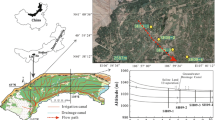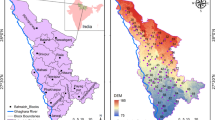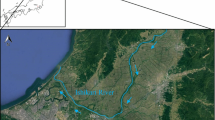Abstract
Excessive arsenic concentrations above the Argentinean and WHO guidelines for drinking water (10 μg L−1) affects shallow aquifers of the southern Pampean Plain (Argentina) hosted in the Pampean and the Post Pampean formations (loess and reworked loess; Plio-Pleistocene–Holocene). Health problems related to high As concentrations in drinking waters are known as Endemic Regional Chronic Hydroarsenicism. Hydrochemistry of shallow groundwaters and soil geochemistry were investigated aiming to (1) understand the partition of As in the solid phase and its relationship with unacceptable As concentrations in waters, (2) identify the provision source of As to groundwaters. Only 5% of the samples had As concentrations <10 μg L−1; in 27% As concentrations ranged from 10 to 50 μg L−1 and in 58% it reached 60–500 μg L−1. The coarse fraction (50–2,000 μm) hosts about 27% of the total As in the solid phase, being positively correlated to Ba (p < 0.01; r 2 = 0.93). About 70% is included in the <2 μm fraction and had positive correlations of As–Fe (p < 0.05; r 2 = 0.85) and As–Cr (p < 0.05; r 2 = 0.68). Soils and sediment sand fractions of vadose zones are the primary sources of As in shallow groundwater while adsorption–desorption processes, codisolution–coprecipitation, and evaporation during the dry seasons raise As concentrations in waters exceeding the guideline value for drinking water.






Similar content being viewed by others
References
Anawar HM, Komaki K, Akai J, Ishizuka T, Takahashi T, Yoshioka T (2002) Diagenetic control on arsenic partitioning in sediments of the Meghna River delta, Bangladesh. Environ Geol 41:816–825
Ayerza A (1917a) Arsenicismo regional endémico (keratodermia y melanodermia combinadas). Bol Acad Medicina 2-3:11–24
Ayerza A (1917b) Arsenicismo regional endémico (keratodermia y melanodermia combinadas) (continuación). Bol Acad Medicina 2–3:41–55
Ayerza A (1918) Arsenicismo regional endémico (keratodermia y melanodermia combinadas) (continuación). Bol Acad Medicina 1–24
Batthacharya R, Chatterjee D, Nath B, Jana J, Jacks G, Vahter M (2003) High arsenic groundwater: mobilization, metabolism and mitigation—an overview in the Bengal Delta Plain. Mol Cell Biochem 253(1–2):347–355
Bea F (1999) Uranium. In: Marshall CP, Fairbridge RW (eds) Encyclopedia of geochemistry. Kluwer Academic Publisher, Dordrecht, pp 645–648
Blanco Mdel C, Paoloni JD, Morrás HJM, Fiorentino CE, Sequeira M (2006) Content and distribution of arsenic in soils, sediments and groundwater environments of the Southern Pampa Region, Argentina. Environ Toxicol. doi:10.1002/tox20219, 561–574
Blanco MdelC, Amiotti NM (2001) Excursion Guide Book. Semi-arid and humid soils of Buenos Aires province, 12 the International Clay Conference and 3rd. International Symposium on Activated Clays, July 22–28, B. Blanca, Argentina 71 pp
Blanco MdelC, Sánchez L, Aguilar Ruiz J (1997) Mineralogía y micromorfología de suelos loessicos con desarrollo moderado en la Llanura Subventánica Occidental Bonaerense, Argentina. Edafologia., Rev Soc Española Cca. del Suelo (2):215–219
Blanco MdelC, Paoloni JD, Morrás H, Fiorentino C, Sequeira M (1999a) Variabilidad espacial del paisaje Pampeano sudoccidental y su influencia en la distribución del ión arsénico en suelos y aguas, Actas. I Congr. Arg. de Cuaternario y Geomorfología. La Pampa, Argentina, pp 25–26
Blanco MdelC, Paoloni JD, Morrás H, Fiorentino C, Sequeira M (1999b) Contenidos de arsénico en suelos-sedimentos y su correlación con la calidad del agua subterránea en el SW pampeano, Argentina, 14 Cong. Lat de la Cca. del Suelo. Pucón, Chile
Blanco MdelC, Sánchez LF (1994) Mineralogía de arenas en suelos loessicos del sudoeste pampeano. Turrialba 4(3):147–159
Blanco MdelC, Sánchez LF (1995) Caracterización de las fracciones limo y arcilla en suelos loessicos del suroeste pampeano en Argentina. Turrialba 45(1–2):76–84
Bundschuh J, Farías B, Martín R, Storniolo A, Bhattacharya P, Cortés J, Bonorino G, Albouy R (2004) Groundwater arsenic in the Chaco-Pampean Plain, Argentina: case study from Robles County, Santiago del Estero Province. Appl Geochem 19(2):163–260
Cabrera A (1976) Regiones fitogeográficas Argentinas. In: Kugler WF (ed) Enciclopedia Argentina de Agricultura y Jardinería, Tomo 2, Fasc. 1., 1–85, Buenos Aires, 1–1408 pp
Camacho LM, Gutierrez M, Alarcón Herrera MT, Villalba L, Shuguang D (2011) Occurrence and treatment of arsenic in groundwater and soil in northern Mexico and southwestern USA. Chemosphere 33(3):211–225. doi:10.1016/j.chemosphere.2010.12.067
Chowdhury UK, Biswas BK, Chowdhury TR, Samanta G, Mandal BK, Basu GC, Chanda CR, Lodh D, Saha KC, Mukherjee SK, Roy S, Kabir S, Quamruzzaman QD (2000) Groundwater contamination in Bangladesh and West Bengal, India. Environ Health Perspect 108(5):393–397
Fiorentino CE (1999) Evaluación y riesgo de la contaminación de los recursos hídricos superficiales en las vertientes del Sistema de Ventania. Tesis de Magister. Universidad Nacional del Sur, Bahía Blanca (Inédito)
Fiorentino CE, Paoloni JD, Sequeira M, Arosteguy P (2007) The presence of vanadium in groundwaters of the southern extreme in the Pampean region, Argentina: relationship with other chemical elements. J Contam Hydrol 93(1–4):122–129
Francisca FM, Carro Perez MEC (2009) Assessment of natural arsenic in groundwater in Córdoba Province, Argentina. Environ Geochem Health 31(6):673–682
Galindo G, Sainato C, Dapeña C, Fernández-Turiel JL, Gimeno D, Pomposiello MC, Panarello HO (2007) Surface and groundwater quality in the northeastern region of Buenos Aires Province, Argentina. J South Am Earth Sci 23:336–345
Gałuszka A (2007) A review of geochemical background concepts and an example using data from Poland. Env Geol 52:861–870. doi:10.1007/s00254-006-0528-2
Gao SJ, Ryu KK, Tanji C, Herbel MJ (2007) Arsenic accumulation and speciation in evaporating waters of agricultural evaporation basins. Chemosphere 67:862–871
Gonzalez Uriarte M (1984) Características geomorfológicas de la región continental que rodea la Bahía Blanca, provincia de Buenos Aires.Actas X Congr. Geol. Argentino, S. C. de Bariloche, Argentina, III:556–576
Heredia OS, Fernandez Cirelli A (2009) Trace elements distribution in soils, pore water and groundwater in Buenos Aires, Argentina 409–414. doi:101016/j.Geoderma.2008.12020
Litter M, Perez Carrera A, Morgada ME, Ramos O, Quintanilla J, Fernandez Cirelli A (2008) Formas presentes de As en agua y suelo. En: Bundschuh J., Litter M. (Editores).Iberoarsen. Distribución del arsénico en las regiones Ibérica e Iberoamericana. 5–32 pp
Manganelli A, Goso C, Guerequiz R, Fernández Turiel J, García Vallès M, Gimeno D, Pérez (2007) Groundwater arsenic distribution in South-western Uruguay. Env Geol 53(4):827–834
McArthur JM, Ravenscroft P, Safiulla S, Thirwall MS (2001) Arsenic in groundwater: testing pollution mechanisms for sedimentary aquifers in Bangladesh. Water Resour Res 37:109–117
MdelC Blanco, Amiotti N, Aguilar Ruiz J (2003) Reconstrucción de la evolución geo-pedogenética en una toposecuencia del sudoeste pampeano. Ciencia del Suelo 21(3):59–70
Morales KH, Ryan L, Kuo TL, Wu MM, Chen CJ (2000) Risk of internal cancers from arsenic in drinking water. Environ Health Perspect 108:655–661
Morrás H, Zech W, Nabel P (1998) Composición geoquímica de suelos y sedimentos loessicos de un sector de la Pampa Ondulada. 2das. Jornadas Geológicas y Geofísicas Bonaerenses, Mar del Plata, I:225–232
Morrás H, Blanco Mdel C, Paoloni JD (2002) Algunas observaciones sobre el origen del arsénico en sedimentos, suelos y aguas de la región Chaco-pampeana, Argentina. II Taller sobre Sedimentología y Medio Ambiente, Resúmenes: 37–38, Buenos Aires, Argentina
Nicolli J, Smedley P, Tullio J (1989) Aguas subterráneas con altos contenidos de flúor, arsénico y otros oligoelementos en el norte de la provincia de La Pampa: Estudio preliminar. Congreso Internacional sobre Aguas, Workshop sobre Química Ambiental y Salud, Libro de Resúmenes, III-3
Nicolli H, Tineo A, García JW, Falcón C, Merino MH (2001) Trace-element quality problems in groundwater from Tucumán, Argentina. In: Cidu R (ed), Water–rock interaction 2:993–996
Nicolli HB, Tineo A, Falcón CM, García JW (2006) Distribución del arsénico y otros elementos asociados en aguas subterráneas de la región de Los Pereyra, Provincia de Tucumán, Argentina En: Galindo G, Fernández Turiel JL, Parada MA, Gimeno Torrente D (eds), Arsénico en aguas: origen, movilidad y tratamiento. II Seminario Hispano-Latinoamericano sobre temas actuales de Hidrología Subterránea, IV Congreso Hidrogeológico Argentino, pp. 83–92
Nicolli HB, Tujchneider O, Paris M, Blanco MdelC, Barros A (2009) Movilidad del arsénico y oligoelementos asociados en aguas subterráneas del centro-norte de la provincia de Santa Fe, Argentina. VI Congreso Argentino de Hidrogeología, IV Sem. Hispano-Latinoamericano sobre Temas Actuales de Hidrogeología Subterránea, Santa Rosa, La Pampa, 1–10 pp
Paoloni JD, Fiorentino CE, Sequeira M, Echeverría N (2000) Spatial variability and concentration of arsenic in the groundwater of a region in southwest Buenos Aires Province, Argentina. J Soil Water Conserv 55(4):436–438
Paoloni JD, Sequeira M, Fiorentino CE, Amiotti N, Vazquez R (2003) Water resources in the semi-arid Pampa–Patagonia transitional region of Argentina. J Arid Environ 53:257–270
Paoloni JD, Sequeira ME, Fiorentino CE (2005) Mapping of arsenic content and distribution in groundwater in the southeast Pampa, Argentina. Int Perspect J Environ Health 67(8):51–53
Partey F, Daid N, Samuel N, Nartey R (2009) Mechanism of arsenic sorption onto laterite iron concretions. J Colloid Interf Sci 321(2):493–500. doi:10.1016/j.jcis.2008.02.034
Polizotto M, Harrey Ch, Guauchau L, Badruzzman B, Ashraf L, Newville M, Sulton S, Fendorf S (2005) Solid-phase and desorption processes of arsenic within Bangladesh sediments. Chem Geol 228:97–111
Rankama K, Sahama ThG (1962) Geoquímica. Ediciones Aguilar SA Seg. Edición. 250 pp
Ratnaike R (2006) Arsenic in health and disease. In: Naidu R, Owens G, Bhattacharya P, Nadebaum P (eds) Managing arsenic in the environment: from soil to human health, CSIRO Publishing, Collingwood, Australia, 297–309
Ruggieri F, Saavedra J, Fernandez Turiel JL, Gimeno D, García Vallés M (2010) Environmental geochemistry of ancient volcanic ashes. J Haz Mater 183:353–365
Smedley P, Kininburgh DG (2002) A review of the source behavior and distribution of arsenic in natural waters. Appl Geochem 17(5):517–568
Smedley P, Kinniburgh DG (2000) Source and behavior of arsenic in natural waters. http://www.who.int/water_sanitation_health/dwq/en/arsenicum1.pdf. Accessed 23 October 2010
Smedley P, Nicolli HB, Macdonald DM, Barros AJ, Tullio JO (2002) Hydrogeochemistry of arsenic and other inorganic constituents from La Pampa, Argentina. Appl Geochem 17(3):259–284
Smedley P, Kinniburgh DG, Macdonald DM, Nicolli HB, Barros AJ, Tullio JO, Pearce JM, Alonso MS (2005) Arsenic associations in sediments from the loess aquifer of La Pampa, Argentina. Appl Geochem 20:989–1016
USGS (United States Geological Survey) (2000) Geochemistry of Arsenic. http://www.or.water.usgs.gov.pubs/online/html/WRI98-4205/as_repot6.html
Tello E (1951) Hidroarsenicismo crónico regional endémico (HACRE), sus manifestaciones clínicas. (ed) Univ. Nac. de Córdoba, Argentina
Welch AH, Stollenwerk KG (2003) Arsenic in groundwater: geochemistry and occurrence. Kluwer Academic Publisher, Borton, 475 pp
World Health Organization (WHO) (1995) Guidelines for drinking water quality. 2nd Ed. I. pp 43–45
Acknowledgments
The authors acknowledge the financial assistance of the Agencia Nacional de Promoción Científica y Tecnológica (ANPCYT) and the Secretaría de Ciencia y Tecnología de la Universidad Nacional del Sur, (SECyT), Bahía Blanca, Argentina. Our thanks are also for reviewers that their contribute to improve our manuscript with their opinions.
Author information
Authors and Affiliations
Corresponding author
Rights and permissions
About this article
Cite this article
del Carmen Blanco, M., Paoloni, J.D., Morrás, H. et al. Partition of arsenic in soils sediments and the origin of naturally elevated concentrations in groundwater of the southern pampa region (Argentina). Environ Earth Sci 66, 2075–2084 (2012). https://doi.org/10.1007/s12665-011-1433-x
Received:
Accepted:
Published:
Issue Date:
DOI: https://doi.org/10.1007/s12665-011-1433-x




